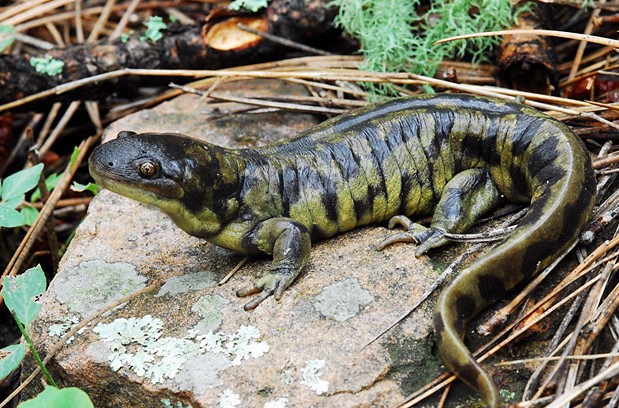Tiger Salamander, Amblystoma triginum nebulosum
by Dan Potts, Salt Lake County Fish & Game Association
This cute little lizard-like amphibian is six to eight inches long, its coloration can be highly variable, although those in our area are usually grey to brown with yellowish spots and patches on their backs and sides. The coloration of the various species of the tiger salamanders found throughout America and into Mexico are highly variable, some reminiscent of tigers.
Our salamander, the only one in Utah, lives from our lowest desert valleys to near its highest mountains. Their habitats range from sagebrush deserts and dry coniferous forests to high alpine ponds and waterways like our own Jordan River. As adults they are mostly terrestrial, but like their larvae are good swimmers. This species usually spends it days under logs and rocks, or in cooler, moister places like animal burrows. They usually come out at night to feed on a wide range of small live animals including mostly insects and worms, but also other amphibians, and even baby mice. They have a good set of teeth, but do not use them to defend themselves, making them the perfect “squeezable” wildlife for children.
Like most amphibians, tigers reproduce by laying eggs in water that hatch into larvae with large external gills, but may only reproduce once in their lifetime. The eggs usually metamorphose into adults as the larvae grow larger, however, unlike most amphibians some of their larvae never go through metamorphosis and are able to breed as larvae, especially in very dry areas with ponds sustained by permanent springs. Unlike many amphibians, tigers have no vocal cords and cannot call. They also differ from most amphibians, usually returning to their own birthplace, if it still exists. The problem is that the typical breeding ponds associated with our primary waterway, the Jordan River, have largely been destroyed by development resulting in an overall decline in tiger salamander populations in Utah, Salt Lake and Davis counties.
Tiger salamander larvae, also known as waterdogs, are probably best known as a fishing bait, especially for America’s number one gamefish, the largemouth bass. Tigers are immune to chytrid, the catastrophic disease that is killing amphibians worldwide. However, transplanting them to new locations as bait can inadvertently introduce the disease to endanger frogs and toads that are not resistant.
I have seen two tigers over the past year or so, one at night on a Wasatch hiking trail while turkey hunting, and another in a restroom in the Uinta Mountains (obviously placed there as a practical joke). Another one was recently photographed leaving the new Fife Wetland Preserve as it crossed the old 9th South Railroad Pylon Bridge instead of choosing to swim across the Jordan.



